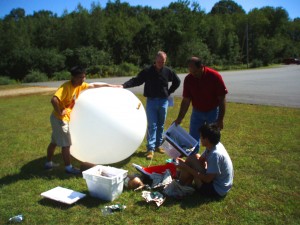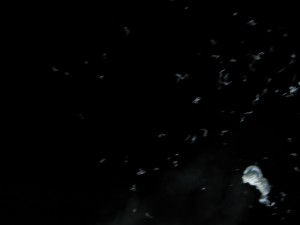Near-Space DIY Aerial Photography for $150
Even though the odds of getting to see the darkness of space in person are slim – just over 500 people have traveled into space – it’s possible to still see it through the lens of your camera with a small assembly project and a few cheaply obtained materials. Including a styrofoam beer cooler.

A team of students from MIT recently set a goal to capture some photos of the curvature of the earth. Their off-the-shelf project cost them approximately $150, and the results have garnered them attention from CNN, Fox, ABC and more. Here’s how they made it:
Equipment Used in the Launch Capsule
| Item | Weight | Cost |
| Sounding Balloon 350g from Kaymont | 350g | ~$20 +$20 (helium) |
| Parachute | ~10g | ~$3* |
| Motorola i290 Prepaid Cellphone | ~90g, | ~$50** |
| Styrofoam Beer Cooler | ~15g | ~$0 |
| Duct Tape | ~10g | ~$0 |
| Zip Ties | ~5g | ~$0 |
| Canon A470 with 8GB SD card | ~165g, | ~$40*** |
| Insulation material- newspaper | ~5g | ~$0 |
| Duracell USB phone charger powered by AA batteries | ~20g 1oz | ~$10 |
| Instant Hand warmer | ~5g | ~$2**** |
| 4 Ultimate Lithium AA batteries | ~15g * 4 = 60 g | ~$5 |
| Radar Reflector (aluminum foil) | ~0g | ~$0 |
| Total | ~800g, /w misc. | ~$150 |
 One of the amazing parts of this project is that there were only two small modifications needed on the materials: The camera used was selected for its ability to use a timed shutter script through the CHDK firmware update (I use this same setup for most of my timelapse films), and the styrofoam cooler allowed for lightweight thermal insulation which can be easily cut to allow the lens of the camera to stick through.
One of the amazing parts of this project is that there were only two small modifications needed on the materials: The camera used was selected for its ability to use a timed shutter script through the CHDK firmware update (I use this same setup for most of my timelapse films), and the styrofoam cooler allowed for lightweight thermal insulation which can be easily cut to allow the lens of the camera to stick through.
Other components of note:
– The pre-paid cell phone was selected for its internal GPS, allowing it to send location information.
– A separate battery pack included to keep the electronics working throughout the 4.5 hour flight.
– The hand warmers were included to provide some protection against the brutal chill of the thin atmosphere at 17 miles high.
An interesting observation: the cell phone they used lost reception at approximately 2500′ in the air. Not even a half-mile high. Commercial flights travel at about 30,000′. From some “inadvertent” tests of my own, I’ve never gotten a signal on an airplane, but am surprised to know that the point where the connection dies is so low to the ground.
Here’s a general overview of the procedure:
Using some styrofoam and foam spacers, place the components inside the styrofoam cooler and secure in place. Instant heat handwarmers will be placed around the electronics. Carefully cut a hole out for the lens of the camera.

Determine the amount of lift/acceleration you want, and fill your balloon with the appropriate amount of helium. The MIT team determined that each cubic foot of helium gas provides 28g of lift, and that each pound of free lift would accelerate the balloon 300 ft/minute.
The balloon itself increased in size from about 5′ to 20′ before popping (as planned). A 5′ parachute was determined to be sufficient to bring the payload back to earth safely. You’ll want to test this yourself if you make any modifications or add weight.
Find a clear location to launch from, and a day with low wind speeds. The launch by MIT took about 5 hours total from launch to touchdown, and traveled approximately 20 miles.

FAA requirements allow you to launch a payload as long as it is under 4lbs, so choose your materials carefully. Still, check in with them to determine proper regulations in your area.
The team also put together a fantastic PDF with details on how to do this yourself. For lots more info and photos, check out the project page itself.
Here’s my suggestion for future launches: More cameras! The single camera helps keep the weight down but allows for a lot of missed shots. Having cameras on all four sides and the bottom would help maintain great photos as the balloon rotates.
Also, including a gyroscopic stabilizer to help keep the container steady too is an interesting experiment too. The DIY hard drive gyro is a possibility that is not overly heavy.


